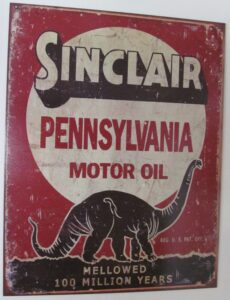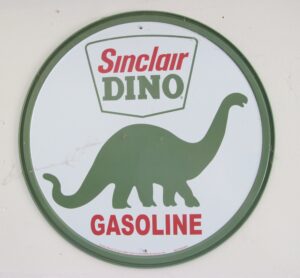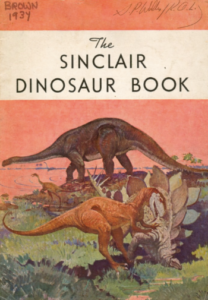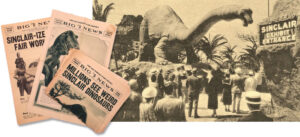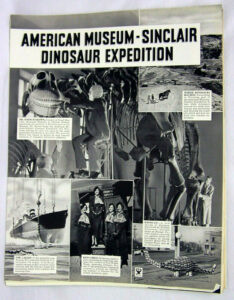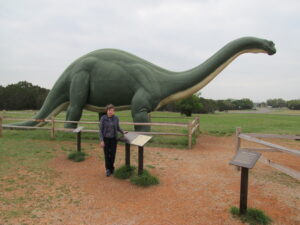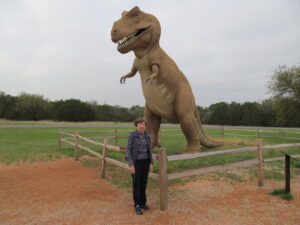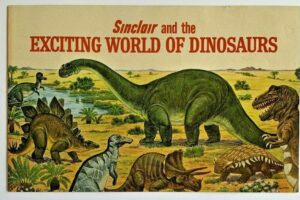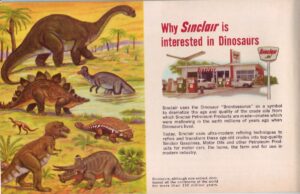Sinclair gas stations were non-existent in the Pacific Northwest when I was a boy. Whenever my family would travel by automobile to the Midwest or Southwest and see Sinclair stations, I was attracted to them because of their prominently displayed DINO logos. I assumed then that since Sinclair used dinosaurs in all of their advertising for petroleum products that they must believe that oil was made from dead dinosaurs. Was I mistaken in this assumption?
Figure 1: Vintage Sinclair Motor Oil Sign from my Garage Wall
Figure 2: Sinclair Gasoline Sign from my Garage Wall

As it turns out Sinclair, initially at least, was indeed hinting at the idea that Sinclair oil and gasoline were made from dinosaurs. There will be more about this later, but first a short history about Sinclair Oil.
Sinclair Oil is one of the oldest continuous names in the petroleum products industry. It was founded by Henry Ford Sinclair (1876-1956) in 1916 by combining the assets of eleven small petroleum companies. Ranked on the list of the largest privately owned American corporations it owns and operates refineries, gasoline stations, hotels, a ski resort, and a cattle ranch. Originally a New York corporation, it was reincorporated in Wyoming in 1976. There are 1400 Sinclair gasoline stations in 29 states in the Western and Midwestern USA that display the DINO corporate logo. [Per Sinclair media letter dated November 7, 2019.]
The DINO logo (and mascot) was originally based on the Brontosaurus dinosaur and Sinclair began using the logo in 1930. The trademark was registered in 1932. Many of you readers; no doubt, think you know that the Brontosaurus genus name has been replaced with Apatosaurus. However, not all secular paleontologists of today believe Brontosaurus should be deleted as a valid genus name. The official current position of Sinclair Oil regarding the proper genus name for which DINO is based reads: “Dinosaur fossils are rare, which makes it difficult to study and classify them. Since 1903, paleontologists have had conflicting opinions about whether the Brontosaurus is its own unique genus, or whether it’s the same as the Apatosaurus. Sinclair has followed the prevailing opinions of the scientific community, which currently favors calling DINO an Apatosaurus – though new research may eventually change that.” [Sinclair website accessed July 18, 2020: DINO History.]
As stated in the 2016 Sinclair Oil Dinosaur Fact Sheet, “Dinosaurs first appeared in marketing for Sinclair Oil as a part of a campaign to educate customers about the origin of fossils fuels.” [The fact sheet is accessible on the Sinclair website.] So, it does seem logical to me that when one reads, “mellowed 100 million years,” one could conclude that the education intended was that Sinclair motor oil came from dead dinosaurs (Figure 1).
Sinclair sponsored a dinosaur exhibit at the 1933-1934 Chicago World’s Fair meant to play on this link between the formation of petroleum deposits and the time of the dinosaurs. Dr. Barnum Brown from the American Museum of Natural History wrote the illustrated 12 page Sinclair booklet for the fair, titled The Sinclair Dinosaur Book (Figure 4).
Figure 4: Brown’s Dinosaur Book for Sinclair’s 1934 Chicago World’s Fair Display
Figure 5: DINO the Brontosaurus at 1934 Sinclair Chicago World’s Fair Display
In the Sinclair Oil full-page advertisement in a 1934 Fortune Magazine, one ad snippet read, “It was while dinosaurs roamed the earth that Nature was mellowing and filtering the crude oils which are now refined into Sinclair lubricants.” See the ad in Figure 6 below.
Figure 6: Sinclair Oil Advertisement in 1934 issue of Fortune Magazine
As indicated in the ad, over the years Sinclair Oil has been involved in sponsoring numerous American Museum of Natural History (AMNH) paleontological projects. In the year that Dr. Brown wrote the dinosaur booklet for Sinclair, his dinosaur fieldwork in Wyoming was funded by Sinclair. Other important paleontologists that cooperated with Sinclair over the years were John Ostrom and Edwin Colbert. In 1938 Sinclair helped fund Roland T. Bird’s work recovering dinosaur tracks along the Paluxy River in Texas. Bird excavated huge slabs of rock containing dinosaur tracks from the Paluxy that ended up at the AMNH in New York City.
Sinclair has used DINO in numerous other large marketing programs including dinosaur stamps, several other fairs and expositions, and many Macy’s Thanksgiving Day Parades, with DINO as a giant balloon. I want to discuss just one other promotion in some detail and that is the 1964 New York World’s Fair. For that fair Sinclair made nine different types of full-size fiberglass dinosaurs and set them up at their Dinoland exhibit. Some 50 million visitors saw the dinosaur reconstructions at the fair. Then, the Sinclair dinosaurs were donated for display at various locations throughout the country. In Figures 7 and 8 can be seen the two Sinclair dinosaurs from the New York fair that ended up at the Dinosaur Valley State Park in Glen Rose, Texas near the Paluxy River.
Figure 7: Apatosaurus Sinclair Dinosaur at Glen Rose, Texas
Figure 8: Tyrannosaurus Sinclair Dinosaur at Glen Rose, Texas
For the 1964 World’s Fair Sinclair printed a 14 page handout on dinosaurs with the dino information in it attributed to Dr. Barnum Brown and Dr. John H. Ostrom. The cover for this booklet is seen in Figure 9.
Figure 9: Sinclair Dinosaur Booklet Cover for 1964 New York World’s Fair
In Figures 10 and 11 are images of how Sinclair explained to the general public in the 1960s why they were so interested in dinosaurs. You can read for yourselves the explanations. I would say that at this time the emphasis in the ads was that dinosaurs are old, and Sinclair oil is old, and the older the oil the better. These claims were certainly not proven facts then, nor are they now.
Figure 10: “Why Sinclair is interested in Dinosaurs” in 1964
Figure 11: Sinclair Oil’s Explanations for Dinosaurs and Petroleum 1964
So, in summary, it is not much of a stretch to say that Sinclair Oil marketing over the years has contributed to the mistaken idea that petroleum in the earth is the result of the demise of dinosaurs. Next let us find out what the current secular theory is for the origin of oil. Consider the quotation in the next paragraph.
“The original theory of the origin of oil in the Western world was that it came from dead animal matter, but a cemetery, where bodies decay and turn to dust, is not a future oil field. For the earth to manufacture a fossil fuel, the decaying process must be interrupted either by dead plant and animal matter falling into oxygen-starved waters or by rapid burial. It was once thought that oil came from dinosaurs, the symbol of Sinclair Oil. This theory has been discredited because the earth could not possibly have sustained a population of dinosaurs, even over millions of years, large enough to create so much oil even if one ignores the special circumstances that must accompany death for dinosaurs to become a fossil fuel. In the twenty-first century the accepted theory postulates that ocean plankton, algae, and other forms of simple marine life die and sink into oxygen-starved waters to prevent further decay. Sediments from rivers mix with the partially decayed matter to form an organically rich concoction. Continued burying by more layers of sediment squeezes out the water, and when buried by a mile of more of new sediment over millions of years, the original sediment is transformed to sedimentary rock and the organic matter to oil.” [Nersesian, Roy, Energy for the 21st Century: A Comprehensive Guide to Conventional and Alternative Sources, Rutledge, 2010, p. 181.]
Do creationists have a good explanation for the origin of oil? It seems clear that oil can be made artificially from organic matter such as animal waste. This has been done commercially. All Biblical Creationists I am aware of agree that there was a cataclysmic global Flood some 4,500 years ago that rapidly buried lots of plants and animals. So, one creationist explanation is that not only coal fields, but oil reserves too, are the result of the rapid accumulation of mainly plant debris through catastrophic global water deposition.*
The secular explanations for coal are deficient. They require imagining millions of years of the compaction of peat, a process that does not fit the evidence. The Bible tells us there were no millions of years, and peat bogs do not look like precursors to coal beds. I think I can accept the creationist explanation for the naturalistic origin of coal as a direct result of Noah’s Flood. However, the origin of oil may be a harder nut to crack.
In the broad picture, it seems there are two naturalistic models for the origin of oil endorsed by experts of secular and creationist camps. One is the biogenic where oil is the result of the decay of living matter, and the other is the abiogenic where oil is somehow directly produced from primordial matter. Creationist John Matthews has proposed a third idea called the theobaric (made by God) model. **
I am certainly not an expert in this field, but so far as I know experts of both secular and creationist camps agree with Nersesian that oil did not originate in any significant amount from dead dinosaurs. No matter the actual origin of oil, mankind must thank our Creator God for his provision of fossil fuels. They have been critical for the technological advancements over the past two centuries and will remain so for the foreseeable future, perhaps until the Lord’s return.
J.D. Mitchell
*DVD: “Recent Rapid Formation of Coal & Oil,” Snelling, Dr. Andrew, Answers in Genesis, 2017.
**Matthews, John, “The Origin of Oil – A Creationist Answer,” Answers Research Journal, December 17, 2008, (available on AiG website).
